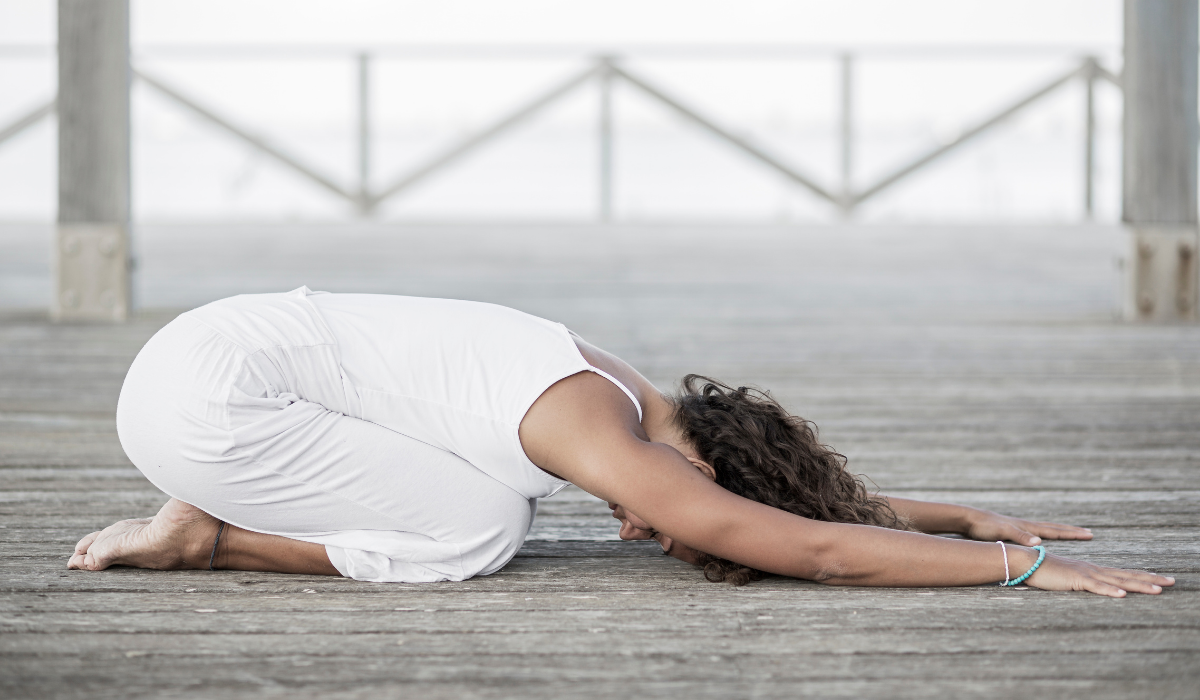The idea that yoga can have a positive effect on your immune system is not ancient folklore, it’s science.

The immune system is a network of glands, nodes, and organs that work to protect the body from “germs” (bacteria, viruses, fungi, and other pathogens). However, a constant supply of energy and specific nutrients are needed to maintain the immune system’s optimal function. Environmental toxins, a poor diet, lack of (or excessive) exercise, and stress can all have an immunosuppressive effect on the body, therefore making us more vulnerable to infection and disease.
As the popularity of yoga has grown over the last few decades, so has the clinical research designed to bust or boost yogis’ claims. If you cynically think “cite your source” when you hear an instructor say certain poses and practices are good for [insert body system here], this is the article you’ve been waiting for.
We have reviewed the research, and offer some science-backed yoga poses that can actually support your immune health through this cold and flu season.
Yoga for systemic health
Different asanas (poses) are purported to have different effects. Some are meant to be stimulatory to the nervous and circulatory systems, some develop coordination and concentration, and others have a calming effect on the body [1]. There is a growing body of data showing the benefit of these poses to not only mental health, but also heart health, blood sugar, exercise endurance, and aerobic capacity [1-6].
Some poses have even been scientifically analyzed for their apparent benefits in certain disease states. One example is the Kapalabhati “skull-shining” pranayama (breathing exercise). This practice is associated with improved glycemic balance. Analysis revealed that abdominal pressure during exhalation in this pose appears to improve the efficiency of β-cells of the pancreas [7].
Try this practice to cleanse the body before meditation. Kapalabhati pranayama is a series of short forced out-breaths through the nose, with passive inhalation in between each breath. Use the abdominal muscles to make the exhale as short and forceful as possible while keeping facial muscles relaxed.
Start with a 30-second practice and never exceed 10-minutes of Kapalabhati breathing. For a detailed explanation and demonstration, visit this link: https://www.youtube.com/watch?v=bY00OwIjPj8
Regular yoga practice can keep what’s within the body working well, but can a yoga practice actually help fend off pathogenic destruction and infectious disease too?
Yoga for immunity
Clinical evidence indicates that yoga and meditation (a common element of, or complement to yoga practice) can have a regulatory role over homeostatic processes related to the interaction between the nervous, endocrine, and immune systems [1].
Nagaratha, et al., report that there is evidence to support the practice of yoga in the “management of communicable diseases including influenza, tuberculosis (TB), and human immunodeficiency virus (HIV) infection [1].” What these diseases have in common is that the health of the immune system is central to the progression of (or recovery from) the disease. In each case, yoga (and meditation or breathwork) has been associated not only with improvement in symptom management, but also a quantifiable reduction in viral load or infection status [8-10].
It has been proposed that yoga may be, scientifically speaking, an effective complementary treatment for the management of communicable diseases [1]. Even meditation alone has been shown to help regulate and balance the levels of circulating immune cells [11]. This is thought to occur due to calming of the neuroendocrine axis [11].
Stress is known to be immunosuppressive, meaning that when you are stressed, your immune system cannot function to its best ability [12]. Both acute and chronic stressors have a measured effect on the sympathetic nervous system and the hypothalamic-pituitary–adrenal (HPA) axis, by which they impair antiviral immune responses and innate immunity, and interfere with the inflammatory pathways [13]. Yoga actually inhibits activity in the hypothalamus, reducing the body’s stress response [14].
Although the overall benefits of a regular yoga practice to relieve or reduce markers of stress in the body may be its strongest physiological contribution to improved immunity, there are some key poses that stimulate the immune system specifically. For example, yoga poses that twist and compress organs can massage and rejuvenate immune organs and channels [14]. Yoga can also help to balance the vital energy required by the immune system.
Key poses for immune function
Parivrtta Utkatasana (revolved chair pose) offers a deep internal twist, “ringing out” the digestive organs and the body’s key detox organs: the liver and kidneys. https://www.youtube.com/watch?v=YqcJu6QuHQc
Kurmasana (tortoise pose) supports the healthy function of the thymus gland [14]. https://www.youtube.com/watch?v=DHDWApjrHd0
Inversions and forward bends, like Adho Mukha Svanasana (Downward-Facing Dog pose) improve the flow of the sinuses and help flush mucus from the lungs [14]. https://www.youtube.com/watch?v=ETSIv8WetjI
Chest and lung openers, like Ustrasana (camel pose) also increase lung mobility, keep nasal passages clear, and flush out the lungs [14]. Back bending also massages the adrenal glands, which can become exasperated due to stress. https://www.youtube.com/watch?v=8q7GxnIFsQo
Restorative Yoga poses (supported and gravity-based) can provide healing benefits during periods of low energy [14].
Yoga for inflammation
Inflammation is an important element of immune health. In a healthy body, infection or injury becomes inflamed to increase blood flow and immune cells to the site requiring healing. The heat of a fever or a swollen area is actually antibacterial, and aids in the healing process too.
The problem with inflammation is that it can easily go awry. There are many common ailments in the body where painful, destructive inflammation occurs when it is unnecessary. This misfiring of the immune system creates damaging reactive oxygen species and can lead to disease development of many kinds.
Asthma is known as a chronic inflammatory disorder and is defined as a reversible obstruction of the airways [15]. It is characterized by wheezing, coughing, difficulty breathing, and chest tightness. On the physiological level, an increase in immune-inflammatory cells can be measured in the blood, correlating with the severity of symptoms [15]. Reactive oxygen species released from these inflammatory cells trigger the tightening of smooth muscle around airways, histamine release, and mucus secretion [15].
In a 6-month randomized controlled study, asthmatic participants who regularly practiced pranayama (yoga breathing) and asanas (yoga poses) experienced reduced inflammatory markers and increased antioxidant levels in their blood work [15]. This quantitative data supports claims that yoga can “open the airways”, release restriction in bronchial tubes, and gradually expand the bronchial capacity.
Another study showed that those with a regular yoga practice sustain less inflammation in response to stress than those without a regular yoga practice [16]. And, the length of time one spends developing their yoga practice is inversely correlated with inflammatory response [16]. In other words, the more expert you become at yoga, the better your body becomes at responding to stress.
Key poses for inflammation
Try a twisted figure 4 pose. This is a restorative pose, which means you won’t be actively engaging muscles. This pose is meant to soothe the nervous system and promote healing in the body, thereby combating inflammation. https://www.youtube.com/watch?v=lMUllSjmLa8
Setu Bandhasana is also often recommended for chronic inflammation. It provides a gentle stretch to your chest, neck, spine, and hips, and may benefit both blood circulation and inflammatory response. https://www.youtube.com/watch?v=EZyBkVBUlG4
Yoga for the lymphatic system
Interconnected with both the immune system and our circulatory system is the ever-important and under-appreciated lymphatic system. The lymphatic system is the main site of adaptive immune cell production (T cells and B cells) to fight antigens such as viruses.
Lymph, a liquid carrying immune cells, is circulated throughout the body, basically bathing cells and carrying away waste products.
Lymph is filtered through lymph nodes, which remove the toxins, bacteria, and other waste so that the clean lymph can go on to continue picking up more waste. When our systems are overloaded with toxins or pathogenic infection, lymph nodes can become inflamed as they must work much harder to detoxify lymph.
Yoga can benefit the function of your lymphatic system, thereby helping to keep you healthy. Poses that have been documented to stimulate lymph flow and clearance are static, isometric contraction, where muscle is flexed in its shortest state (think straight legs vs. bent) [17].
Key poses for Lymphatic Function
Elevation of legs is often recommended for those with lymph circulation issues [18]. Yoga poses that combine both isometric muscle contraction and elevated legs may be especially beneficial to stimulating lymph flow.
Navasana (boat pose) and Sarvangasana (shoulder stand) are two poses that combine leg elevation with extension and isometric contraction. https://www.youtube.com/watch?v=8KsyQvwi85Q and https://www.youtube.com/watch?v=g3wvIPXZ-Qo, respectively.
- Nagarathna, R., H. R. Nagendra, and Vijaya Majumdar. “A perspective on yoga as a preventive strategy for coronavirus disease 2019.” International Journal of Yoga 13.2 (2020): 89.
- Chobe, Shivaji, et al. “Impact of Yoga on cognition and mental health among elderly: A systematic review.” Complementary Therapies in Medicine 52 (2020): 102421.
- Butterfield, Nicole, et al. “Yoga and mindfulness for anxiety and depression and the role of mental health professionals: a literature review.” The Journal of Mental Health Training, Education and Practice (2017).
- Semple, Randye J. “Yoga and mindfulness for youth with autism spectrum disorder: review of the current evidence.” Child and adolescent mental health 24.1 (2019): 12-18.
- Sinha, B et al. “Energy cost and cardiorespiratory changes during the practice of Surya Namaskar.” Indian journal of physiology and pharmacology vol. 48,2 (2004): 184-90.
- Field, Tiffany. “Yoga research review.” Complementary therapies in clinical practice 24 (2016): 145-161.
- Raveendran, Arkiath Veettil, Anjali Deshpandae, and Shashank R. Joshi. “Therapeutic role of yoga in type 2 diabetes.” Endocrinology and Metabolism 33.3 (2018): 307-317.
- Visweswaraiah, Naveen K, and Shirley Telles. “Randomized trial of yoga as a complementary therapy for pulmonary tuberculosis.” Respirology (Carlton, Vic.) vol. 9,1 (2004): 96-101.
- Naoroibam, Rosy, et al. “Effect of Integrated Yoga (IY) on psychological states and CD4 counts of HIV-1 infected patients: a randomized controlled pilot study.” International journal of yoga 9.1 (2016): 57.
- Dunne, Eugene M., et al. “The benefits of yoga for people living with HIV/AIDS: A systematic review and meta-analysis.” Complementary therapies in clinical practice 34 (2019): 157-164.
- Infante, Jose R., et al. “Levels of immune cells in transcendental meditation practitioners.” International journal of yoga 7.2 (2014): 147.
- Marsland, Anna L., et al. “Stress, immune reactivity and susceptibility to infectious disease.” Physiology & behavior 77.4-5 (2002): 711-716.
- Falkenberg, R I et al. “Yoga and immune system functioning: a systematic review of randomized controlled trials.” Journal of behavioral medicine vol. 41,4 (2018): 467-482.
- Arora, Sarika, and Jayashree Bhattacharjee. “Modulation of immune responses in stress by Yoga.” International journal of yoga 1.2 (2008): 45.
- Agnihotri, Shruti, et al. “Impact of yoga on biochemical profile of asthmatics: A randomized controlled study.” International journal of yoga 7.1 (2014): 17.
- Kiecolt-Glaser, Janice K., et al. “Stress, inflammation, and yoga practice.” Psychosomatic medicine 72.2 (2010): 113.
- Havas, Eino, et al. “Lymph flow dynamics in exercising human skeletal muscle as detected by scintography.” The Journal of physiology 504.1 (1997): 233-239.
- Mortimer, Peter S., and J. Rodney Levick. “Chronic peripheral oedema: the critical role of the lymphatic system.” Clinical Medicine 4.5 (2004): 448.
Share:
Related Posts

Goodbye Pie Chart, Hello Phase 1 Sliders
Written by Allison Smith, ND | 2025 As we usher in a new era of DUTCH testing which leaves behind the concept of the three-way

Introducing the DUTCH Dozen
Written by Kelly Ruef, ND | 2025 Hormone testing can be complex, which is why Precision Analytical developed the DUTCH Dozen, an interpretive framework that

DUTCH Report Enhancements
Written by Hilary Miller, ND | 2025 Precision Analytical have released the newest version of the DUTCH Test. This is the report’s most significant update

Gallbladder Health 101: What It Does and How to Keep It Working Well
Written by Ashley Palmer & Pooja Mahtani | 2025 The gallbladder may not get much attention compared to the gut, but it plays a central

Can You Bring Vitamins on a Plane? How To Travel with Supplements
Written by Austin Ruff | 2024 Are you traveling for a work conference, an athletic competition, or a weekend getaway? Just because you’re leaving home

